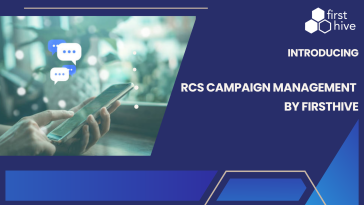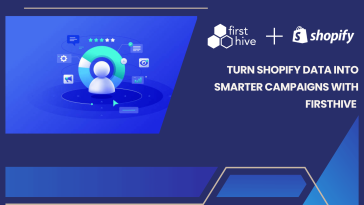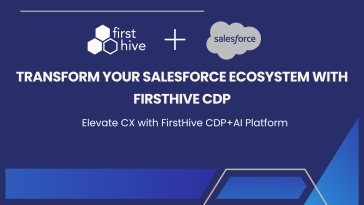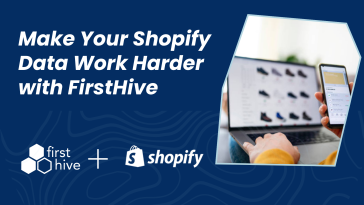“I wanted to begin somewhere. So, I grabbed a paper, doodled some shapes with connecting arrows. To someone who didn’t understand my gameplan, it would look like Egyptian symbols. Being a Brand Manager, this is the best way I could vomit my hypothesis in print. My hunch tells me, this will work because I remember my data team has information that supports my hypothesis. I just need my marketing campaign manager to send those few computations to validate this.”
Just like this, data keeps moving in circles around your organization. Despite huge data-crunching technologies, information is stranded among inaccessible data teams, often too far from your reach.
Security of such data is equally compromised as it is circling in the mailbox, excel files, data tables, disintegrated data gathering tools or the CRM. The disadvantage falls back onto the marketer. You need something more than a CRM. Especially, B2C marketers work with large data sets and doodling will not come to rescue.
B2B marketers have a stated advantage to personalize content and push it out in the market when compared to the B2C segment. Customer segmentation and audience mapping for B2B marketers is a lot more visible, digestible, perceivable, and coherent than for B2C marketers.
Which is why, in this article, we focus on articulating ardent challenges of a B2C marketer, instances that can transform these challenges into opportunities, and a technology solution that can help you optimize on these opportunities.
B2C Customer Segmentation Challenges
For B2C marketers, Individualized Personalization is an ideal scenario and a dream project. But, with limited resources, complex market conditions, and media mix constraints a marketer from personalizing customer experiences. Also, the large numbers, fragmented characteristics, and scattered places make individualization an almost impossible process.
Limited resources, complex market conditions, and media mix constraints a marketer from personalizing customer experiences.
In most scenarios, this compels a marketer to segment customers based on mere demographic parameters. While, in reality, a marketer is capable and can be equipped to segment customers also based on geographic, behavioral, psychographic, social, cultural and customer-lifetime value grouping-characteristics.
Even better, FirstHive sees that a marketer can gain intelligence with further granular segmentation. These help in establishing contexts and identifying intents while sending out a communication or designing a campaign.
So, here we are presenting a few instances of how B2C businesses can master the art of customer segmentation, tackling the existing challenges, and how you can use more than demographics to get closer to customers.
Before, that here is a quick overview of different dimensions that you could use to segment your customers.
Different Parameters that Provide Opportunities for Customer Segmentation
Geographic Segmentation: The micro-parameters used to create customer segments by geography are continent, country, region, state, district, city, and relevant time zones. Some marketers also choose to use language, cultural preferences by each parameter, if the campaigns are multi-lingual and/ or based on the customer’s cultural needs.
Business Value: If you have past data of the business value contributed by each customer, then you could grade customers based on their potential to purchase a product or respond to a marketing campaign. You may want to pay more attention to those customers who carry high average values.
Purchase behavior & Product Preferences: Seasons and festivities influence purchase behavior. These not only indicate physical weather, but also the trends that concern your customers. Among them, you may also want to use family demographics or other similar data to segment customers based on product preferences. Product usage, loyalty, interests, awareness, spending patterns, mode of payment, knowledge, and demands help in defining segments based on behavior.
Channel behavior: Each cohort can be also segmented based on how they respond to content on different channels that they engage with. It also provides information about the probability of conversion of the customers that you want to interact with on respective channels.
Psychographic segmentation: Social class, lifestyle, personality, values, digital media exposure and social presence determine psychographic segmentation.
Device Usage: Customers respond to brand communication in different ways on mobile phones, tablets, desktops, television, radio, cinema screens, kiosks or any other device that they are exposed to. Also, the nature of the information that they leave back is different when the customer has logged into the mobile app or is experiencing the product via a desktop login.
Data Beyond Visibility: Apart from the above-mentioned parameters, there is a lot of unstructured and dark data that marketers try and decipher. These also provide valuable insights into customer segmentation.
However, the challenge still remains in creating more intelligent and integrated customer segments that are based on marketing objectives, which could be plugged into each marketing campaign. In fact, a marketer is more keen on creating customer identities using each parameter mentioned above rather than creating mere segments.
This helps a marketer to enrich each customer segment and identity based on the response to preceding marketing campaigns and behavior.
Customer Segmentation in the B2C scenario
A consumer interacts with your brand during different contexts with various intents. Mapping such unpredictable and haphazard journey to a single customer segment is not just daunting, but non-profitable. Integrating journeys and individual customer segments to marketing campaigns is what makes a richer customer experience.
For instance, a bank’s customer representative reaches out to a customer via a phone call to educate and sell about a product based on the data provided. But, your automated email campaign may also blast out an email cadence using email marketing data, which ignores the CRM call data. This creates confusion among your internal marketing systems with regard to the stage of a customer in relation to the success of a product’s sale.
Similarly, using your customer segments, a customer is informed about an in-store offer via an SMS to your customer. But, you could also be running a conflicting offer that is generalized to all potential customers. Sometimes, a customer may receive a repeated offer after the purchase completion. Your retargeting criteria may continue to reach out to the same customer for having viewed the product in your online store before the offline purchase. These details are often revealed better when the segmentation in linked to customer data of enriched profiles, supported by auto-segmentation. A mere CRM does not serve the purpose, here.
Mass marketing in the absence of customer segmentation is easy to execute, but it would be an inefficient process with futile results. On the contrary, a well-articulated customer segmentation strategy would provide marketing efficiency, better brand strategy, improve distribution strategies, customer retention, and determine new market opportunities. This strategy should also include a consideration to use technology that can be better than an existing CRM.
Customer Data Platforms (CDPs) that gather data from across all sources of information and transaction, integrate with multiple data systems to constantly rectify the data quality, and uses AI to enrich cohort segmentation provides assured promise to deliver more than a CRM. This is the linchpin to eliminate B2C customer segmentation challenges.
A Customer Data Platform is the Linchpin to eliminate B2C Customer Segmentation Challenges.
FirstHive, as a Customer Data Platform using artificial intelligence and machine learning to automate customer segmentation and provide cohort recommendations. Feel free to reach out to us to discuss your customer segmentation queries.








